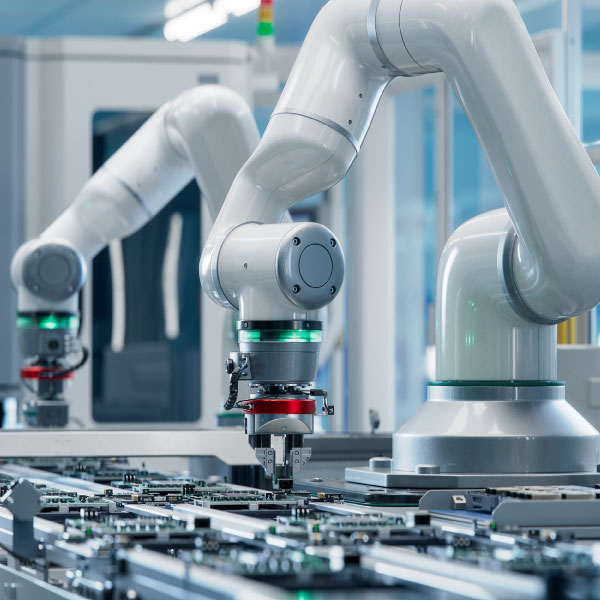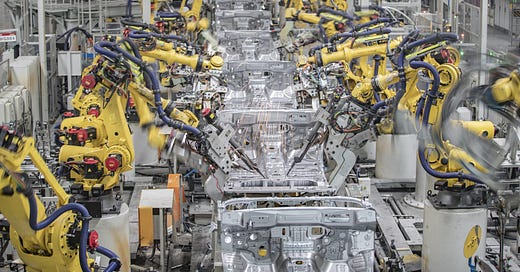
US Manufacturing Growth Slows in March as Output Falls and Costs Surge
PMI Says “Growth”—But Beneath the Surface, US Manufacturing Is Starting to Crack
The March 2025 US Manufacturing PMI came in at 50.2, narrowly avoiding contraction territory and beating the preliminary estimate of 49.8. On paper, that sounds like good news. But the numbers tell a more nuanced story—one where rising costs, stagnant hiring, and waning confidence suggest that the post-pandemic recovery in manufacturing is beginning to lose steam.
The PMI, or Purchasing Managers' Index, is an economic indicator derived from monthly surveys of purchasing managers. A reading above 50 generally indicates expansion in the manufacturing or service sector, while a reading below 50 suggests contraction.
In an economy still adjusting to tariff shocks and volatile global demand, the latest PMI data serves less as a green light and more as a flashing yellow. The headline expansion masks deeper structural strains—and for investors, executives, and policymakers alike, that signal warrants closer attention.
1. PMI Above 50—but Momentum Is Fading
A PMI reading above 50 generally signals expansion. But the March figure of 50.2 represents the weakest growth rate of the year and a sharp drop from February’s 52.7. In effect, we’re looking at a manufacturing sector that’s barely staying afloat.
US Manufacturing PMI Trends Over the Past Year: A Comparative Analysis of ISM and S&P Global Indexes
| Month/Year | ISM Manufacturing PMI | S&P Global US Manufacturing PMI | Note |
|---|---|---|---|
| March 2025 | 50.3 | 49.8 | ISM shows slight expansion; S&P indicates contraction. |
| February 2025 | 50.3 | 52.7 | ISM showed slight expansion; S&P indicated stronger growth. |
| January 2025 | 50.9 | 51.2 | Both indexes indicated expansion. |
| December 2024 | 49.2 | 47.9 | Both indexes indicated contraction. |
- Output fell for the first time since December, reversing February’s surge—an outlier driven by preemptive production ahead of expected tariff hikes.
- New orders nearly stalled, underscoring weak demand, especially from domestic customers.
- While export orders picked up, led by stronger activity in Canada and the EU, this uptick wasn't enough to offset slowing local momentum.
For manufacturers, this signals the end of the early-year rebound and the beginning of what could become a slow grind—especially as global supply chains normalize and stimulus effects fade.

2. Employment Breaks a Four-Month Growth Streak
After four consecutive months of job gains, manufacturing employment slipped in March. The pullback reflects a shift in sentiment across the sector: firms are growing more cautious, especially as input costs surge and margins tighten.
Hiring freezes or job reductions, even small ones, are often leading indicators of operational belt-tightening. When combined with slower output and flat new orders, this drop in employment signals that manufacturers are preparing for leaner times ahead.
Labor market softness in this sector could ripple out to related industries—from logistics to industrial services—potentially dampening consumer spending in regions heavily reliant on manufacturing.
3. Inflation Pressures Surge: Costs and Prices Both Climb
One of the clearest warning signs in March’s data is input cost inflation, which jumped to its highest level since August 2022. Manufacturers are also raising output prices at the fastest pace in over two years, driven in part by tariff-related pressures.
Summary of US Manufacturing Input Cost Trends
| Index/Metric | Reporting Period | Value | Trend/Commentary |
|---|---|---|---|
| ISM Manufacturing Prices Index | February 2025 | 62.4 | Increased significantly from 54.9 in January, marking the fifth consecutive month of price increases and the highest level since June 2022. |
| ISM Manufacturing Prices Index | January 2025 | 54.9 | Rose from 52.5 in December 2024, indicating accelerating price increases for raw materials. |
| ISM Manufacturing Prices Index | December 2024 | 52.5 | Increased from 50.3 in November 2024, showing continued expansion in input prices. |
| U.S. PPI Final Demand (YoY) | February 2025 | +3.2% | Year-over-year increase in final demand prices reflects persistent inflationary pressures. |
| U.S. PPI Intermediate Demand | February 2025 | +10.5% | Unprocessed goods for intermediate demand saw a sharp year-over-year increase, signaling strong input cost hikes. |
| NY Fed Regional Survey (Mfg.) | February 2025 | +7.3% | Manufacturers expect input costs to rise by an average of 7.3% in 2025, a significant jump from 2024. |
Tariffs, which are taxes levied on imported goods, increase the price of foreign raw materials and components essential for production. Consequently, this raises overall manufacturing costs for businesses relying on these imports and can disrupt established supply chains.
The implications:
- Margins are under pressure. Companies unable to pass these costs downstream will face profitability declines.
- Consumers will start to feel the squeeze if these price hikes spill over into retail goods.
- The Fed—already walking a tightrope—may find its inflation outlook complicated by rising industrial costs.
This is especially problematic for manufacturers operating in low-margin sectors like textiles, auto parts, or basic metals, where price elasticity is limited.
4. Business Confidence Hits a Low Not Seen Since December
Perhaps the most telling data point in the PMI report is not related to output or prices—it’s sentiment. Business confidence among manufacturers has now declined for two straight months, hitting its lowest level since December.
Summary of U.S. Manufacturing Business Confidence and Sentiment Trends
| Index | Period | Value | Trend vs Previous Month |
|---|---|---|---|
| ISM Manufacturing PMI | March 2025 | 49.8 | Decreased (-0.5 pts) |
| ISM Manufacturing PMI | February 2025 | 50.3 | Decreased (-0.6 pts) |
| ISM Manufacturing PMI | January 2025 | 50.9 | Increased (+1.7 pts) |
| NFIB Small Business Optimism | February 2025 | 100.7 | Decreased (-2.1 pts) |
| NFIB Small Business Optimism | January 2025 | 102.8 | Decreased (-2.3 pts) |
| NFIB Small Business Optimism | December 2024 | 105.1 | Increased (+3.4 pts) |
The cause? A growing sense of uncertainty tied to federal policy ambiguity, particularly around tariffs, tax credits, and environmental regulations.
When CEOs don’t know what’s coming next from Washington, they hold back on investments. That hesitancy slows down plant upgrades, reshoring initiatives, and capital expenditures—leading to a feedback loop that dampens both output and hiring.
For investors, this dip in sentiment should not be underestimated. Confidence drives capital allocation decisions—and a confidence vacuum often leads to underperformance in industrial stocks.
5. What This Means for Investors: Risks, Signals, and Sector Strategy
The PMI data doesn’t scream crisis, but it whispers caution across several fronts. For market participants, the implications are material:
- Earnings pressure is coming. As input costs rise and demand plateaus, expect to see earnings downgrades from firms lacking pricing power.
- Stock volatility may increase. Manufacturing-sensitive indices could face short-term corrections if weaker order books start translating into lower forecasts.
- Sector bifurcation is likely. High-tech manufacturers with strong automation, diversified supply chains, and exposure to export markets will fare better than traditional producers reliant on low-cost inputs and legacy systems.
Winners:
- Advanced manufacturers with strong R&D pipelines and AI-driven automation (e.g., industrial robotics, semiconductor equipment).

Advanced robotics arm operating precisely in a cleanroom environment, representing high-tech manufacturing. (ayeruham.com) - Companies positioned for reshoring tailwinds or green energy infrastructure.
Reshoring in manufacturing refers to the practice of bringing production operations back to a company's home country after previously moving them overseas (offshoring). This strategic decision is often driven by economic factors and perceived benefits, such as improved supply chain resilience or reduced transportation costs, and is distinct from onshoring which may not involve a return from prior offshoring.
Losers:
- Labor-intensive, commoditized manufacturers with narrow margins.

Traditional assembly line with many workers performing manual tasks, representing labor-intensive manufacturing. (substackcdn.com) - Sectors most exposed to trade friction or tariff dependency, like automotive components and heavy machinery.
Manufacturing’s Balance Point—and What to Watch Next
The March PMI may still show growth—but it’s a razor-thin line between progress and pullback. Beneath the headline, the cracks are forming: slowing output, shrinking confidence, and rising costs are combining into a complex mix of fragility and uncertainty.
For investors and business leaders, this is not the time for blind optimism. It's a time for strategic positioning—favoring efficiency, flexibility, and long-term resilience over short-term momentum.
The big question now is: Will this softness pass, or are we witnessing the early signs of a broader industrial slowdown?